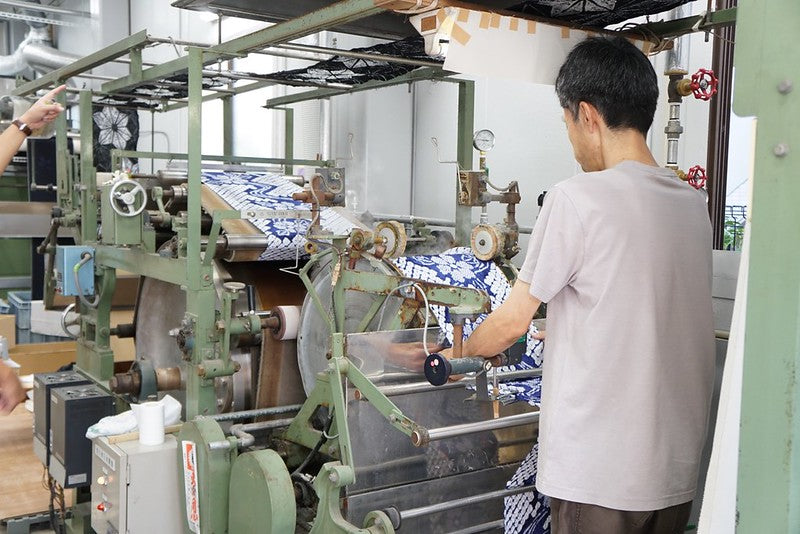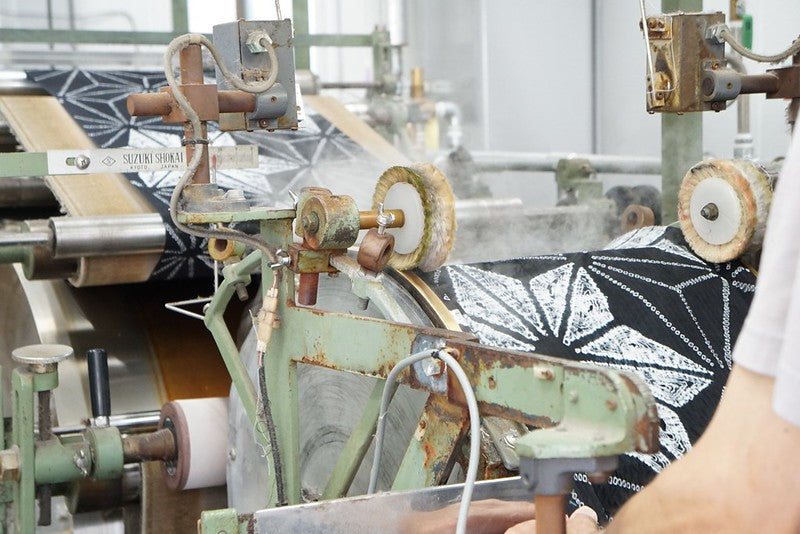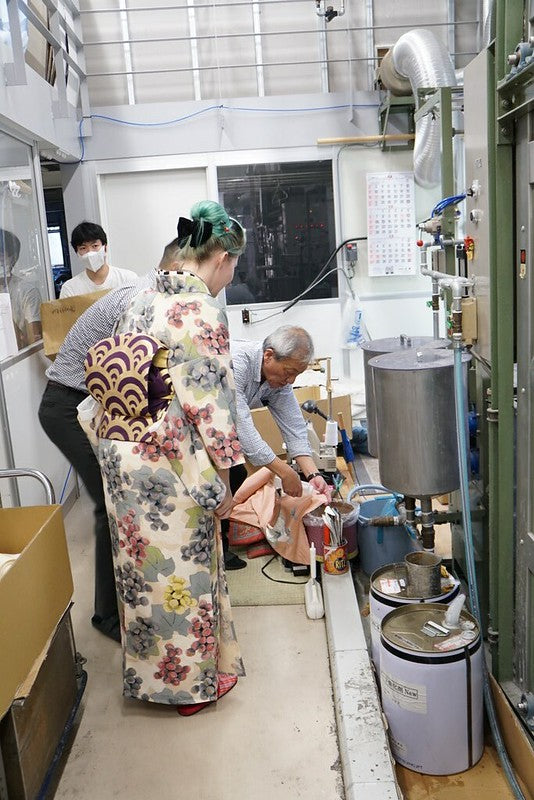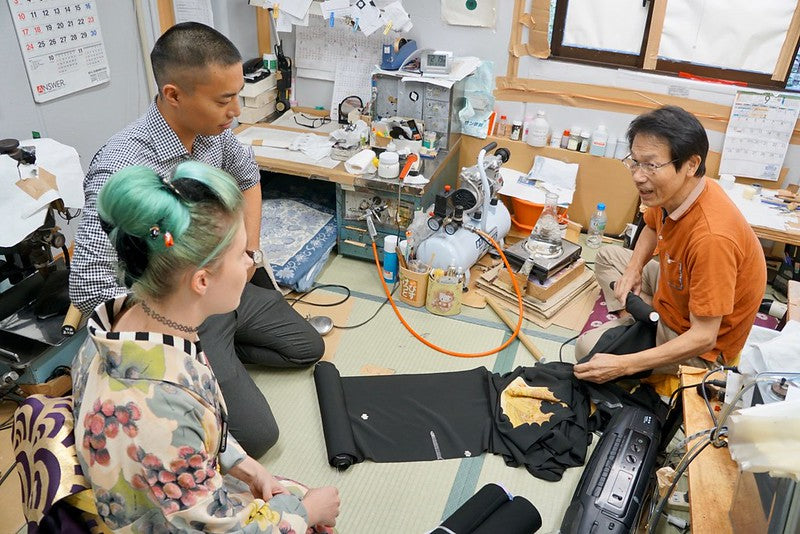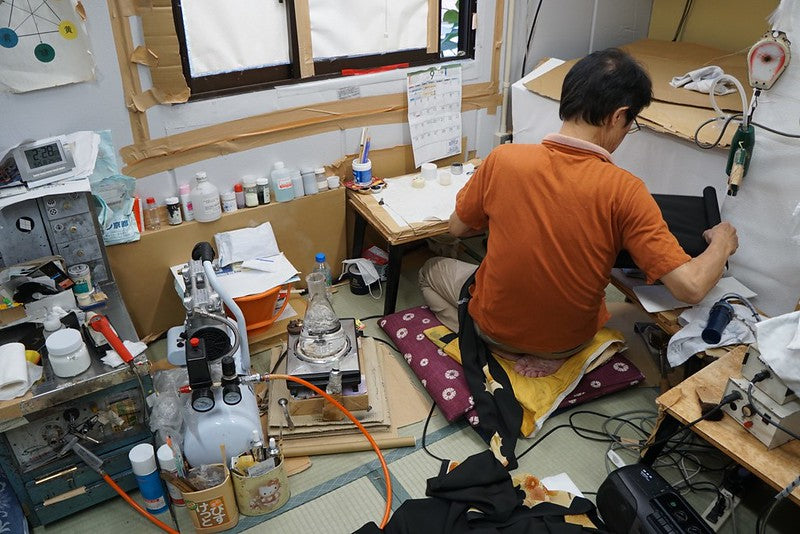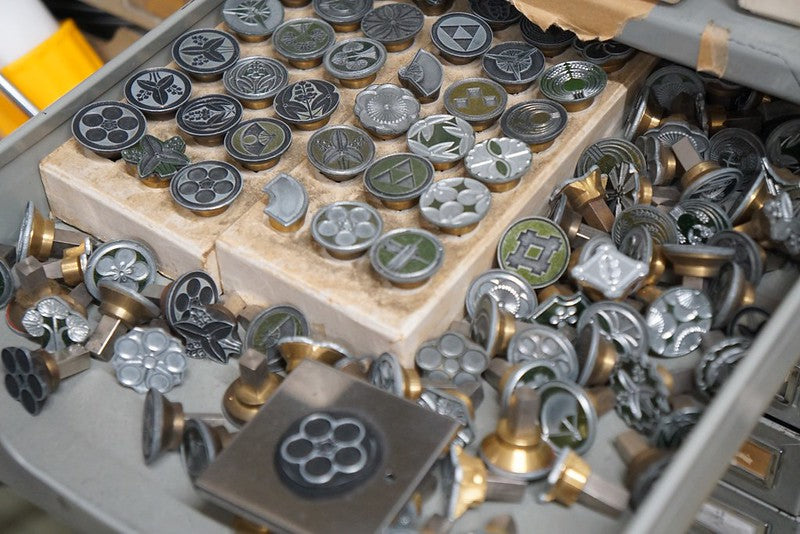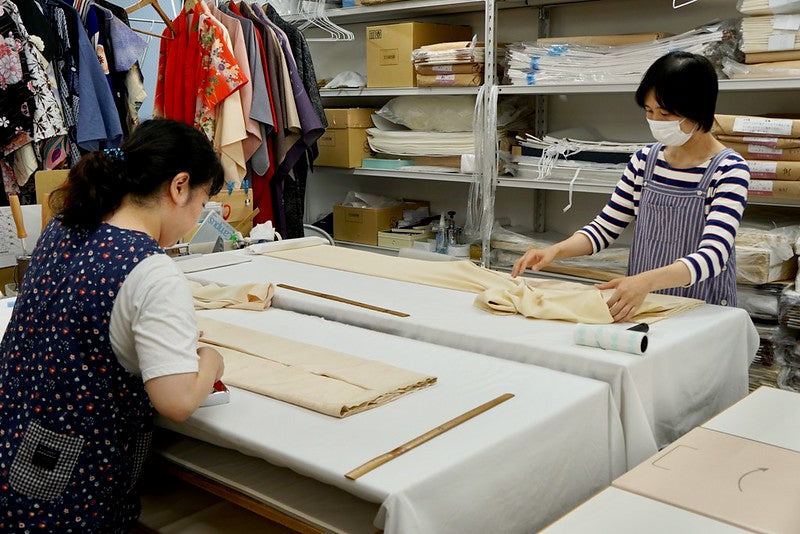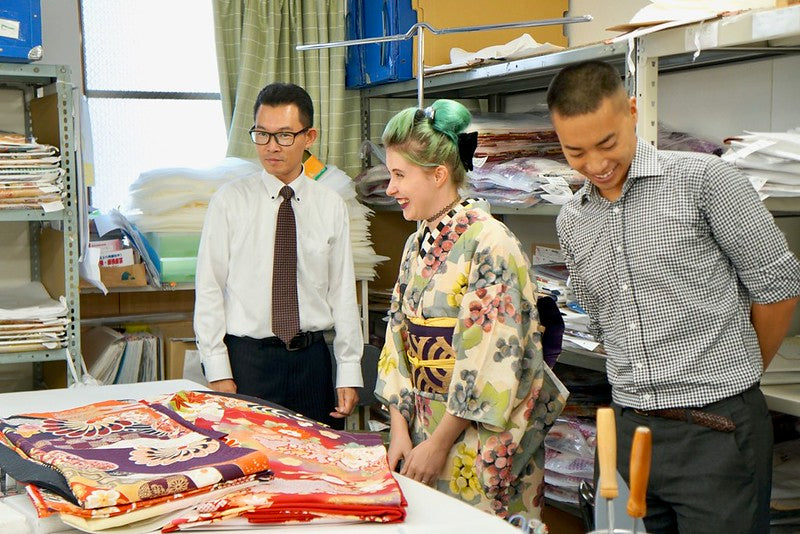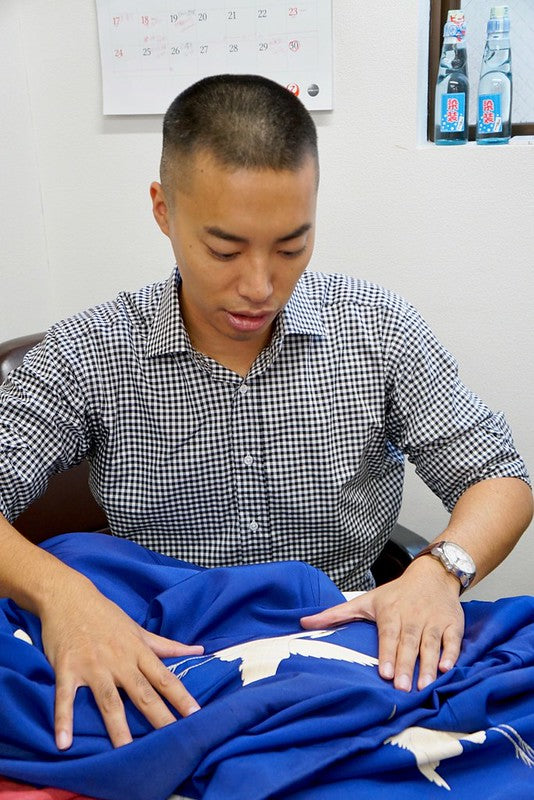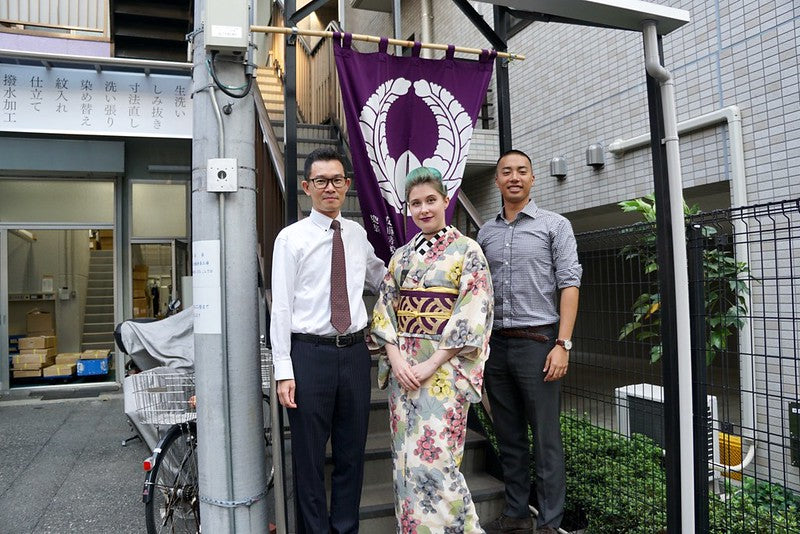「悉皆業とは?」Kimono cleaning & maintenance workshop visit
Ever wondered how kimono are cleaned or maintained? A while back I had a pleasure to visit ANDO TAKASHI Dye Factory – a traditional company which does professional cleaning and restoring of kimono as well as new made to order kimono (“ANDO”).
こんにちは。いかがお過ごしですか?最後に着物を着たのはいつでしょうか?毎日着れるなら、着たいお着物ですが、食べこぼしとか怖いですよね。
少し前ですが、着物の洗い張りや修理及びオーダーメードの着物をしておられる安藤孝染工場(以下、安藤)さんにお話を伺いながら見学させていただきました。
Curious as to how such an operation may look from the inside I paid them a visit. The staff of ANDO showed me around and explained what they do.
The longer you wear the kimono, the thinner the threads get. The threads of the areas which get stretched often i.e. the hip area and the armpit area when tying up with Obi belt may be too weak and cut over years. To mend this, there is a traditional kimono wash/repair technique of “Arai-hari” (洗い張り).
Traditionally, kimono are taken apart into each part and sewn back into their original fabric shape – a 12.5 meter long x 37 cm width fabric bolt. As you may know, kimono parts have no curve, unlike western clothes, so that it is possible to re-make the rectangular original fabric shape. On the 1st floor, there are the machines for “Arai-hari” process.
どのようなお仕事場なのか、安藤さんの歴史、お着物の洗い方、メンテの方法を知る貴重な機会を頂きました。
着物(特に絹のもの)は、縮んだりしてしまうため家では基本的に洗うことができません。本格的に洗う場合は、専門家にお任せするのが基本です。ドライクリーニングは、着物を縮まさせず洗うための基本的な加工ですが着用時の表面的な汚れを落とすためで衿元のファンデーションや食べこぼしなどを落とすためにはしみ抜きが必要となってきます。
長く着られた着物は縫い糸が弱ってきます。無理に着用を続けると力が入りやすい部分(お尻や帯を締めた際の脇の付け根など)の縫い糸が切れてしまうことがあります。このようなときのために伝統的な手法で「洗い張り」という方法があります。洗い張りは一度着物を全て解き各パーツごとにします。着物は裁断、縫製で一切のカーブがないので各パーツを仮縫いすると反物の状態に戻ります。一着分の長さは巾37センチ、長さ12メートル50センチにもなります。工場の一階には、それらに使用する大きな機械が所狭しとならんでいます。
Arai-hari / 洗い張り means “Arai = wash” and “Hari = Expand” in Japanese. Where did this name come from? Expand here means “to dry”. The act of expanding the textile to dry. The re-assembled fabric bolt is to be washed by water first. Professionals know how to wash the silk kimono with water, however if trying at home, the fabric most likely gets shrieked and out of shape or the silk patchy.
The photo shows the machine resizing the shrunk kimono textile – called “Yu-noshi”. Steaming while pulling the textile from the edges can resize the textile to the original size. A well experienced artisan works with this machine adjusting manually and carefully based on the textile with different sizes millimeter by millimeter.
そして、洗い張りの名前の由来は「洗ってから張って乾かす」というところから来ています。よって解かれた着物は反物になり水で洗います。絹やデリケートな着物が水で洗えるのは洗い張りのときのみです。水で洗った着物は巾が縮みます。写真の機械は巾が縮んでしまった着物を元に戻す作業を行う機械で、その作業が「湯のし」です。生地の端を引っ張りながら蒸気を当てて巾を広げた生地を形状記憶させます。この作業は職人が手元でミリ単位で誤差がある反物の巾に合わせて機械を操作しています。
湯気にもまれながら働かれています。尊敬です!
Not only for Arai-hari process, but also “Yu-noshi” is for a new textile which has shorter length than it should be. The Kimono textile in general starts shrinking right after being sewn. Before making a complete kimono, Yu-noshi process makes the size as it should be.
湯のしは洗い張り後の着物以外にも仕立て前の新品で仕立て寸法に足りていない生地に対しても行われます。織られた時から反物は縮みだしているので、仕立て前に湯のしで本来の巾に戻してあげるそうです。
As a silk kimono owner I am often worried to stain the kimono when having dinner with friends or a day out in the city. But there is a method to make the kimono water repellent. Let’s say you spill red wine on your kimono – with this technique it will pearl right off the fabric.
This treatment of kimono can be done at ANDO too, with help of this large machine.
If that isn’t great news!?
私自身、正絹の着物をもっていますが、それを着て食事(特にトマトソースなど、色の強い食べ物!)や、友達と遊ぶときは、シミがつかないか気を使います。この会社さんでは、なんと撥水加工をしてくれるんです。赤ワインをこぼしても、しみ込まないで落ちてくれるので、もう大丈夫(基本的に!)。この機械をつかって撥水加工をしています。
これはとてもいいですね!!
– A company with a long tradition –
Founded in 1879, ANDO specialized in dyeing black kimono such as Mofuku, Montsuki. Evolving with the ever changing industry and needs it is now in the 5th generation and offering various services surrounding kimono maintenance, cleaning and dyeing and sewing both in Japan and overseas.
安藤さんは長い歴史をお持ちです。1879年(発明王エジソンさんが白熱電球を発明した年どえす)に創業され、喪服や紋付きなどの黒い着物専門に染めていました。そこから、今の五代目まで移り変わる業界のニーズに応えながら、着物のお手入れ、直し、染め、国内と海外縫製など行っております。
ANDO is a type of business called ” Shikkaigyo (悉皆(しっかい)業) ” which means “doing all about Kimono well”. There are numerous artisans and companies involved making kimono and Shikkaigyo is one important role to connect all. Based on the needs of customers, ANDO does the jobs in house as well as outsourcing.
Upstairs, in a quiet room apart from the large machines the artisans specialized in the “kamon” aka family crest can be found. Over time, hand drawn family crests might get dull or the kimono gets passed on to another family which needs to change the crest to their own family. All this can be done here. With several tools the crest can be removed with a special chemicals steam and later drawn back on. The company can put almost all family crests (seen in “Monten/紋典/family crest dictionary”).
これを着物業界では「悉皆(しっかい)業」といいます。悉皆とは「悉(ことごと)く皆」という意味で「着物に関する加工を悉く、皆問題なく解決する」といったところになるでしょうか。着物業界には一つの着物を完成させるまでに数多くの職人や加工業者がいるので、お客様と全ての加工業者の間を取り持つ人が必要になります。それが悉皆業です。安藤さんでは自社で行う加工とアウトソーシングする加工をうまく分けてお客様の満足する加工を実現しています。
二階には、一階の機械音にあふれる感じとは対照的に、とても静かなお部屋がありました。そこには、家紋を入れる職人さんが働いていらっしゃいます。着物も長年着ていると、手書きの家紋の輪郭がぼけてきたり、世代を経るタイミングなどで、家紋が変わる場合もあります。ここでは、これらにすべて対応してくださります。特殊な薬品で紋を落として新たな紋を入れたり、紋典に載っている紋の全てがある型を使い、どのような紋にも対応しています
Sewing of the kimono is conducted at their company in HCMC, Vietnam. Around 200 seamstresses there have been trained for years and are guided by a Japanese kimono professional with 1st level Wasaishi certification (一級和裁士) to ensure top quality. (Actually, one of my favorite foods is Vietnamese. One day I would like to visit their factory in Vietnam too.)
On the top floors of the company, the sewn kimono are ironed, double checked and carefully wrapped to be shipped to their respective owners.
安藤さんでは自社でベトナムのホーチミンで縫製工場を営んでいます。そこでは200人の縫い子さんたちが働いています。また日本人の一級和裁士の職人さんが現地常駐で指導にあたっておられる上、30年以上前に日本の企業で初めて着物の縫製工場として進出しているので、長年の経験をつんだ和裁職人さんが多数おられるそうです。ベトナム料理(パクチー最強!)が大好きなので、いつか、ベトナムにいったら、縫製工場も見学させていただきたいなぁ!!
最上階では、縫製された着物のアイロンがけ、品質チェックがされていました。その後、丁寧に包装され、お客様の元へ送られます。
So many gorgeous Furisode! I love all the vivid colors. とてもきれいな振袖ですね。鮮やかな色が素敵です!
Can my old kimono be saved?
I brought a very stained and sunburned kimono for Mr. Ichikawa to analyze. Quite a difficult case.
シミだらけの着物をもっていって、市川さんに診断をお願いしました。シミが多すぎて、かなりの技術を要するようです・・・。ちなみにシミをつけたのは私ではありませんよ(ホント!)。
Interview with Mr. Ichikawa of ANDO
今回、工場を案内してくれた市川さんへインタビュー(私の履歴書風? 笑)です。
1. Tell us about you and yourself? 自己紹介をお願いします!
A. I am a manager of sales department of ANDO and project manager for WA TAILOR which offers custom made iromuji kimono online. On weekdays I am usually around at the Kimono wholesalers and retailers in Nihonbashi area, Tokyo. On weekends I do seminars what to do with kimono with a lot of dirt, mold, sizing for kids etc.
With WA TAILOR, I do web promotion of kimono for the young. By the way, the kimono beauty in the promotion video is my wife. I hired her to cut the cost, haha.
有限会社 安藤孝染工場 営業部営業課 主任と色無地のカスタムメイドのウェブサービスを提供しているWA TAILOR(ワ テイラー)事業部のプロジェクトマネージャーを兼任しています。
営業部では平日は中央区日本橋界隈のお得意の問屋さんや小売屋さんを車で周り、いろいろなお仕事をいただいたりしてプロのお客様と直に顔を合わせることをしています。毎日のようにウロウロしてますので見かけたら声をかけてくださいw
週末は日本全国にある小売のチェーン店さんにお邪魔して着物のお手入れ相談会を実施して個人のお客様に対し、お家で眠っている着物がカビやシミで大変なことになってしまった、お子様やお孫さんにお着物を譲りたいので寸法をどうしようなどの着物に対するご相談をお受けするクリニックを開催しています。
WA TAILOR事業部では事業の立ち上げからマネジメントをしています。前職の経験やこの業界ではあまりいない若年層の感覚を取り入れた着物選びや着物の敷居を低くするための試みを日々考えwebを使って世界に発信していくための活動をしています。ちなみにプロモーション動画に出てくる着物美女は経費削減のため妻を採用しましたw
2. How did you start your career? いまのお仕事につくきっかけは?
A. I started out as a part time creator (then later full time managing projects) at FOURDIGIT – web development company for about 10 years. When I first joined, the company had as few as 20 employees. When I left, it was more than 100 employee company. This experience became an important base in my current job to make a organization better.
After this company I lived in Australia for one year. My hobby was backpacking and I wanted to live overseas. After I came back to Japan, I asked myself what mattered to me most and thought the family business of my mother side, ANDO, is the one. This was why I joined ANDO.
前職は渋谷(現在は青山)にあるFOURDIGITというweb制作会社で10年弱、勤めていました。こちらでは19歳からアルバイトのクリエイターとして働きだして、後に正社員になりプロジェクトマネジメントなども行っていました。入った当初は20名弱でワイワイやっていた会社が辞める頃には100名を超える組織になっていく様を肌で感じた経験が今の職場でも常により良い組織にするためにはどうしたらいいかというのを考える基本になっていると思います。前職の方たちに読まれたら市川が何言ってるんだと笑われそうで恥ずかしいですねw
その後はwebの世界では自分はこれ以上輝けないなと感じ、以前からバックパッカーで旅行をするのが趣味だったので海外に住んでみようと思い1年ほどオーストラリアに住んでいました。
帰国後に今後の人生を考えて、自分が何から形成されているんだろうと思ったときに幼少期から側で見てきた母方の家業である安藤染工が自分の根本かなという結論に至り入ることを決意しました。
3. Childhood / Adult memories/hobby? 子供の頃又は大人になってからいい思い出や趣味を教えてください。
A. I was the basist of a band called “99RadioService”. When we did gigs in early time, there were not many audiences and I thought I had to have some skill and joined the web development company. After a while, we could debut with indies and major label and released CDs. Even though I left the band I am still supporting the band and wishing their success.
一つ前の質問で19歳からweb制作会社で働いていたと答えましたが、その理由が仕事の傍らでやっていた音楽活動です。
99RadioServiceというバンドでベースを弾いていましたが活動を始めた頃はライブでもガラガラの状況だったので手に職をつけないといけないと考えて始めた仕事が前職です。
その後、バンドではインディーズレーベルとメジャーレーベルでCDデビューもできました。私は脱退してしましましたが一部のメンバーは今も頑張っているのでこれからも活躍してほしいなと思っています。
4. Best way to relax? とてもお忙しそうですが、普段の生活で一番のリラックス方法は?
A. I love the sea. In summer I do scuba diving in some area with not many people around. I can relax looking at some fishes, and also looking at some bonfire at camping.
海が好きなので、夏は人のあまりいない海に行きシュノーケルをつけて、ただ魚を眺めているのがリラックスできていいですね。あとはキャンプに出かけて焚き火を眺めるのもリラックスできますw
5. What is your future plan? 夢とか・やりたいことありますか?
A. I want to bring Kimono much closer to people. I do not mean I want people to wear it everyday but I want to lower the price to make kimono more affordable. If pure silk, the high price is understandable but there is no transparency in pricing in Kimono industry and I think this may keep young people away from Kimono. There are many high end kimono. Yet, I as a kimono producer, would like to offer something with quality yet not expensive.
着物を身近なものにしたいです。
毎日着るというよりも、適正価格や手に届くといった意味が近いかもしれません。
正絹の着物はシルクですし値が張るのは理解できますが、今の着物市場は値段が不明確だったり値段が釣り上げられているようなものが多いように感じ、それが着物が売れていた時代の感覚を引きずっていて私の同年代や若い人たちの金銭感覚と離れているのが着物離れの要因になっているのではと考えています。
高級品があるのは当然ですが、しっかりとした品質で適正な価格の着物を我々造り手が消費者に直接提供出来るようになりたいです。
6. Tips for kimono wearer overseas how to wash, maintain? (海外の着物愛用者へのアドバイスを!)
A. Friends in overseas tell me that popularity of “Japanese things” are on rise.
In our company including our factory there are several English speaking employees (not strange today’s Japan, but not so common in our industry). We have a patterner who did theater costume for more than 10 years in the US.
So if you have anything with Kimono, please write to us. The shipping cost may be something but we will try our best. I also would like to do Kimono seminar with Anji SALZ in overseas too (!).
海外の友人たちから話を聞いていると海外での和モノの人気の高まりをヒシヒシ感じています。
幸運なことに我々の工場には私を含め、英語が話せる人間が何人か在籍しています。(今の日本では普通なことですが同業の中では珍しいと思います)
アメリカで10年以上、舞台衣装のパタンナーをしていた面白い経歴の社員もいます。
なので、もし海外で着物のことでお困りの方がいましたら英文のままで結構ですのでメールを送ってください。送料はかかってしまいますが、海外でもしっかりと対応させていただきます!
将来的には、SALZさんと一緒に海外で着物を愛用されている方向けに「お着物相談会ツアー」を海外で行いたいですね!お誘い待っていますw
6a. What if a drink spills on kimono? What to do first? 着物に飲み物をこぼした場合はどうする?
A. I know many different opinions on this but if you spill on kimono, do not rub or hit by a wet napkin or handkerchief. It can cut the texture on the Kimono surface and the rubbed area sometimes gets strangely shiny.
Do not do too much but just use and press a dry handkerchief at it and let the liquid transfer from kimono to the handkerchief. After this, please bring the kimono to us!
いろいろな意見があると思いますが、こぼしてしまった直後におしぼりや濡れたハンカチなどで擦ったり叩いたりするのは禁物です。
着物表面の繊維が切れて光が乱反射するスレになってしまうことがあります。
こぼしてしまったら、その場でどうにかすることはせず乾いたハンカチなどで押さえて表面の液体をハンカチに染み込ますくらいにしましょう。
その後に我々のような専門業者にお持ちになってください。
6b. Best way to maintain kimono at home? お家で着物の扱い?オススメ?
A. When you buy kimono from shops, the kimono often comes in a paper wrapping called “Tatoushi”. When you store it, please remove the thin paper in the package. That thin paper is only to keep the Kimono at the same position in the Tatoshi package. If you do not remove it, the thin paper does not let kimono breath and the discoloration and mold may happen. (Anji: I did not know that either!!)
Tomesode and Homongi with gold decoration should not be stored with the thin paper, tissue paper or towel in between. The gold part can be floating over years and if you have a thin paper etc. in between, the gold part may be destroyed. My recommendation is not to do anything when storing. If the gold part of one kimono stuck to the other kimono, you can make gold decoration on the other kimono to make it look nice.
仕立て上がりやお手入れが完了すると新しいタトウ紙に入って持って帰ると思いますが、しまう前にタトウ紙の中に入っている薄紙は取ってからしまうことをオススメします。なぜかといいますと、あの薄紙は輸送時にタトウ紙内で着物が寄ったりズレたりするのを防ぐためのものなので一緒にしまうと薄紙が湿気を含み、変色やカビの原因になることがあります。
また、留袖や訪問着に金彩が施されている場合に薄紙、ティッシュ、タオルを挟むのはオススメできません。金彩は経年劣化で表面がペタペタしてくることがあります。薄紙などを挟んでいるとそれらが金彩にくっついてしまい、補正が難しいです。オススメのしまい方は「何もしない」です。もし金彩が着物の別のところについてしまった際は柄や金彩を足して補正することができ、仕上がりもキレイになります。
その他にも着物のことでお困りのことがありましたら、安藤孝染工場のwebサイトからお問い合わせください!
Thank you so much for inviting me and taking so much time showing me around!
工房見学の機会をいただきありがとうございました。お忙しい中にかかわらず、皆さん優しく説明してくださいました。
今回の記事、いかがでしたか? うちにきて!という着物業界の方がいらっしゃいましたら、ご連絡ください!
For more info ぜひ、会社のページもご覧ください!:
有限会社 安藤孝染工場
http://www.senso-inc.co.jp/index.html
Thanks for reading!
Anji





























